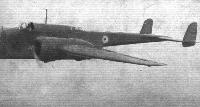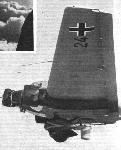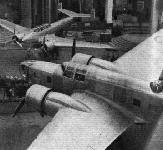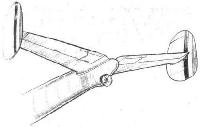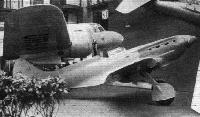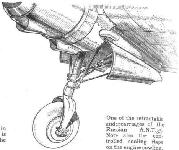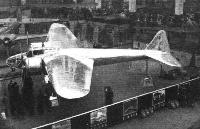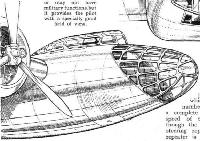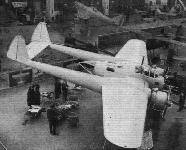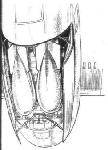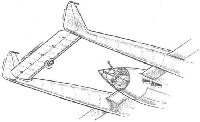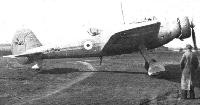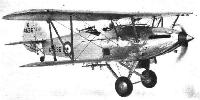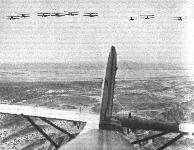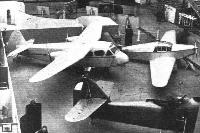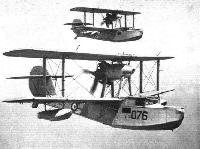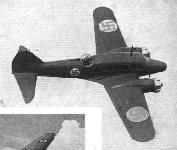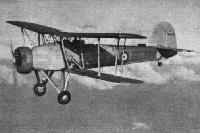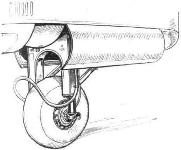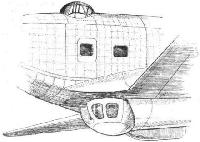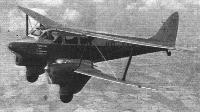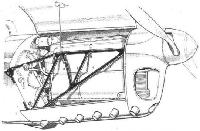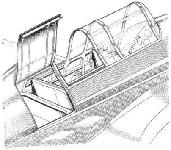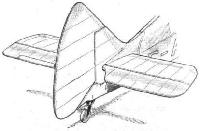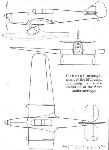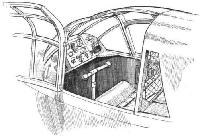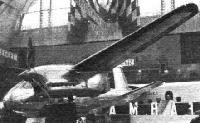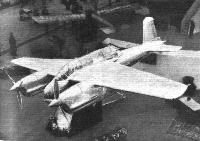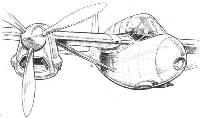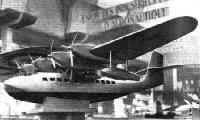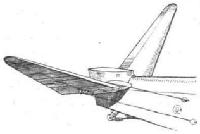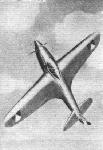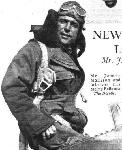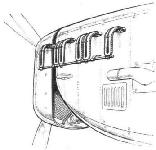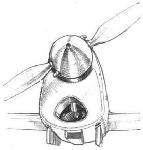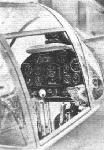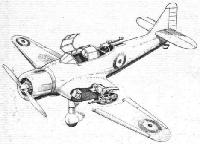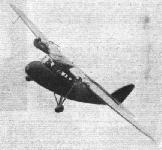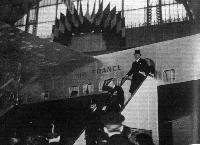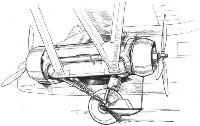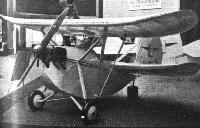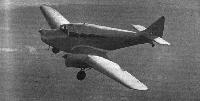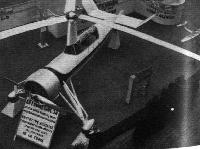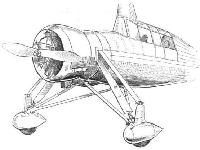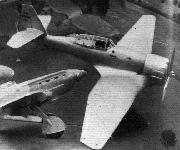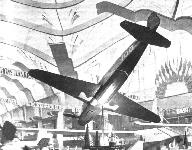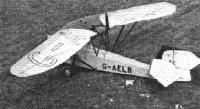Фотографии
-
Регистрационный номер: K4586 The prototype Whitley, K4586, seen during its first public appearance at the RAF Display at Hendon on June 27, 1936.
With two 795 h.p. Tiger IXs the new Armstrong Whitworth Whitley heavy bomber has a fine performance for a machine of its size.Самолёты на фотографии: Armstrong Whitworth Whitley / A.W.38 - Великобритания - 1936
-
Регистрационный номер: K7033 The Mercury-engined Bristol Blenheim is the fastest bomber in the world and has been adopted as a standard R.A.F. type.
Самолёты на фотографии: Bristol Blenheim - Великобритания - 1936
-
Регистрационный номер: K7034 Britain to the Fore: The first machine is the Bristol Blenheim bomber. Behind it is seen the Amiot high-speed, all-metal mail plane.
Самолёты на фотографии: Amiot Amiot 340/350 - Франция - 1937Bristol Blenheim - Великобритания - 1936
-
Field of view, both for the pilot and any of recumbent member of the crew, has certainly been adequately provided in the Bristol Blenheim.
Самолёты на фотографии: Bristol Blenheim - Великобритания - 1936
-
The retractable tail wheel installation
Самолёты на фотографии: Bristol Blenheim - Великобритания - 1936
-
Регистрационный номер: PH-ALI [2] MODERN TRANSPORT: K.L.M.'s first D.C.3 at Croydon last Saturday. So far as this view is concerned the only really noticeable difference between this machine and its predecessor is in the fin form. The fin now extends along the fuselage in order to give better directional stability.
Самолёты на фотографии: Douglas DC-3 / C-47 Skytrain/С-53 Skytrooper / Dakota - США - 1935
-
Регистрационный номер: PH-ALI [2] SHADOW AND SYMMETRY: The smooth lines of the Douglas D.C.3 are well shown in this Flight photograph of K.L.M.'s Ibis taken at Croydon last Saturday.
Самолёты на фотографии: Douglas DC-3 / C-47 Skytrain/С-53 Skytrooper / Dakota - США - 1935
-
Регистрационный номер: K4240 The striking lines of the H.P.52 medium bomber are well brought out here.
Самолёты на фотографии: Handley Page Hampden / H.P.52 - Великобритания - 1936
-
One of the military Junkers Ju.52s, large numbers of which are said to be in service. They have three B.M.W. Hornet engines and, it will be noted, a "dustbin" turret.
Самолёты на фотографии: Junkers Ju.52/3m - Германия - 1931
-
The Marcel Bloch 131 bomber seems a very practical machine, considering that it achieves over 250 m.p.h. with more than 2,000 lb. of bombs. In the background, the Potez 63.
Самолёты на фотографии: Bloch MB.130 / MB.131 - Франция - 1934Potez Potez 63 - Франция - 1936
-
The tail of the new twin-engined Potez 63 three-seater fighter-bomber.
Самолёты на фотографии: Potez Potez 63 - Франция - 1936
-
Fast single-seater fighter which is making its first public appearance at the Grand Salon: the Russian 2KB-19 with M.100 liquid-cooled engine
Самолёты на фотографии: Поликарпов И-17 - Россия - 1934
-
The retractable undercarriage and wing radiator of the Russian single-seater fighter is of contrasting pattern to that of the commercial type (top right).
Самолёты на фотографии: Поликарпов И-17 - Россия - 1934
-
One of the retractable undercarriages of the Russian A.N.T.35. Note also the controlled cooling flaps on the engine cowling.
Самолёты на фотографии: Архангельский, Туполев ПС-35 / АНТ-35 - Россия - 1936
-
The rear defensive arrangements on the P.Z.L. 43.
Самолёты на фотографии: PZL P.23 / P.43 Karas - Польша - 1934
-
A Dornier heavy bomber (two liquid-cooled B.M.W.s) about to dive through a cloudbank preparatory to attacking a target below. Although it might be suggested that this is a composite picture there is no evidence on the original to prove this.
Самолёты на фотографии: Dornier Do.13 / Do.23 - Германия - 1934
-
Регистрационный номер: G-ADSR The sketch gives a rough idea of the layout of the A.W.27 (four Tiger IX) for Imperial Airways.
Самолёты на фотографии: Armstrong Whitworth Ensign / A.W.27 - Великобритания - 1938
-
The Amiot 341 mailplane is exhibited with one Gnome-Rhone and one Hispano engine. This machine is credited with a speed of about 300 m.p.h.
Самолёты на фотографии: Amiot Amiot 340/350 - Франция - 1937
-
The transparent nose of the Amiot 341 may or may not have military functions,but it provides the pilot with a specially good field of view.
Самолёты на фотографии: Amiot Amiot 340/350 - Франция - 1937
-
The Boulton Paul Overstrand medium bomber was the first machine with a power-driven gun turret to be adopted by the R.A.F.
Самолёты на фотографии: Boulton Paul Overstrand / P.75 - Великобритания - 1933
-
Designed for fighting, attack, bombing and reconnaissance work, the Fokker G.I Le Faucheur (which, being interpreted, might be The Grim Reaper) is estimated to do 292 m.p.h. with Bristol Mercury VIIs. It carries two Madsen canons and three machine guns, which should make very effective sickles in a ground strafe.
Самолёты на фотографии: Fokker G.I Le Faucheur - Нидерланды - 1937
-
The bomb traps arrangements in the twin-engined Fokker G.I.
Самолёты на фотографии: Fokker G.I Le Faucheur - Нидерланды - 1937
-
The tail of the Fokker G.I. The booms are of metal construction.
Самолёты на фотографии: Fokker G.I Le Faucheur - Нидерланды - 1937
-
Three-view general arrangement drawings of the Fokker G.I
Самолёты на фотографии: Fokker G.I Le Faucheur - Нидерланды - 1937
-
Регистрационный номер: K7556 Самолёты на фотографии: Vickers Wellesley - Великобритания - 1935
-
Регистрационный номер: K4049 A medium bomber of impressive appearance and performance, the first Vickers twin-engined "geodetic" monoplane has been adopted by the R.A.F. under the name Wellington.
Самолёты на фотографии: Vickers Wellington / Type 271 - Великобритания - 1936
-
THE BIG PARADE. Savoia Marchetti S.81 long-range bombers, with variegated craft beyond, looking pretty for Il Duce at the Lonate Pozzolo airport, near Milan.
Самолёты на фотографии: Savoia-Marchetti / SIAI SM.81 Pipistrello - Италия - 1935
-
Регистрационный номер: K4094, K4100 The Mercury-engined Gloster Gauntlet is well established in the R.A.F.
Самолёты на фотографии: Gloster Gauntlet - Великобритания - 1929
-
Регистрационный номер: K4636 A typical Hawker two-seater biplane: the Hind light bomber (R-R. Kestrel V) as used by the R.A.F.
Самолёты на фотографии: Hawker Hind - Великобритания - 1934
-
FOR DESERT SERVICE. During the recent war in Abyssinia some of our bomber squadrons stationed in the desert of the Sudan were temporarily equipped with Vincent aircraft which are specially fitted out for work over the trackless wastes. In this picture we see No. 207 (Bomber) Squadron practising attacks in the Sudan. On return to England the squadron surrendered its Vincents and went back to ordinary Home type bombers.
Самолёты на фотографии: Vickers Vincent / Type 266 - Великобритания - 1932
-
A dramatic "shot" of a two-seater Heinkel making a climbing attack, the dark object in the foreground being the muzzle and vane foresight of a defending gunner's weapon.
Самолёты на фотографии: Heinkel He-45 - Германия - 1932
-
On the Czech stand the tail of the Letov general-purpose machine is in the foreground. Beyond it is the twin-pusher Praga E.210, and finally the Benes Bibi-Be 550
Самолёты на фотографии: Benes-Mraz Be.550 Bibi - Чехословакия - 1936Letov S-328 / S-528 - Чехословакия - 1932Praga E-210 / E-211 - Чехословакия - 1936
-
125-KNOT CRUISERS: Short Singapore III reconnaissance flying boats of No. 230 (F.B.) Squadron which is being added to the establishment at Singapore. Singapores are still being delivered to R.A.F. units and are powered with four Rolls-Royce Kestrel engines rated at 675 h.p. at 3,000 ft.
Самолёты на фотографии: Short Singapore III / S.19 - Великобритания - 1934
-
AT CALCUTTA: Singapore flying boats of No. 230 (F.B.) Squadron moored on the River Hoogli. They arrived at Seletar station, Singapore, on November 6.
Самолёты на фотографии: Short Singapore III / S.19 - Великобритания - 1934
-
Supermarine Stranraer flying boats with 850 h.p. Bristol Pegasus X engines are under construction for the R.A.F. Note, in this view, the "bomb tanks" for long-range work.
Самолёты на фотографии: Supermarine Stranraer - Великобритания - 1934
-
Регистрационный номер: A2-2 A pair of Supermarine Walrus naval amphibians with Pegasus engines operating as pushers.
Самолёты на фотографии: Supermarine Walrus/Seagull V - Великобритания - 1933
-
Регистрационный номер: G-ACRN This particular Avro 652 is one of two used by Imperial Airways. Later models incorporate certain improvements.
Самолёты на фотографии: Avro Anson / Type 652 - Великобритания - 1935
-
The particular Avro Anson is one of a batch for Finland. Similar machines are used in large numbers by the R.A.F.
Самолёты на фотографии: Avro Anson / Type 652 - Великобритания - 1935
-
Регистрационный номер: K5934 The Fairey Swordfish is a torpedo spotter reconnaissance type used by the Fleet Air Arm.
Самолёты на фотографии: Fairey Swordfish - Великобритания - 1934
-
The Handley Page Harrow. The picture gives a good idea of the large size of this new heavy bomber and shows the positions of the central and rear gunners.
Самолёты на фотографии: Handley Page Harrow / H.P.54 - Великобритания - 1936
-
Регистрационный номер: F-ANXI, F-AOMY, F-AYOW Numerous Progeny: Four of the seven Caudron types shown. In the foreground is the Rafale (C.690 ???) fighter trainer. Beyond are (on the left) the Simoun four-seater and (on the right) the Ramier. The Goeland bought by Mrs. Amy Mollison is in the background.
Самолёты на фотографии: Caudron C.440 / C.445M Goeland - Франция - 1935Caudron C.500 / C.520 / C.620 / C.630 Simoun - Франция - 1934Caudron C.690 Rafale - Франция - 1936Caudron C.800 Ramier - Франция - 1936
-
The Messier retractable undercarriage on the Caudron Goeland.
Самолёты на фотографии: Caudron C.440 / C.445M Goeland - Франция - 1935
-
Upper and lower gun positions on the Bloch 131.
Самолёты на фотографии: Bloch MB.130 / MB.131 - Франция - 1934
-
The Tipsy cantilever monoplane (25 h.p. Sprite).
Самолёты на фотографии: Tipsy S - Бельгия - 1935
-
Самолёты на фотографии: De Havilland Express Air Liner / D.H.86 - Великобритания - 1934
-
Регистрационный номер: G-ADYG Popular De Havilland biplane: the 86a transport machine with four Gipsy Six engines
Самолёты на фотографии: De Havilland Express Air Liner / D.H.86 - Великобритания - 1934
-
Регистрационный номер: G-ADMT Popular De Havilland biplane: the Hornet Moth (Gipsy Major), a side-by-side two-seater for private or club
Самолёты на фотографии: De Havilland Hornet Moth / D.H.87 - Великобритания - 1934
-
Регистрационный номер: VP-YAX Popular De Havilland biplane: the Gipsy Major-powered twin-engined Dragonfly for the private owner and light commercial work
Самолёты на фотографии: De Havilland Dragonfly / D.H.90 - Великобритания - 1935
-
Регистрационный номер: G-ADAD Although showing unusual economy the Heston Phoenix (D.H. Gipsy Six) has an excellent all-round performance.
Самолёты на фотографии: Heston Phoenix - Великобритания - 1935
-
Регистрационный номер: G-AEKN [3], G-AEKW [3] Attractive in appearance as well as performance the Mohawk will doubtless become the envy of many a private owner.
The photograph shows the same aircraft at Woodley with the incorrect registration G-AEKN applied instead of G-AEKW. It is rumoured that the aircraft still exists.Самолёты на фотографии: Miles Mohawk / M.12 - Великобритания - 1937
-
Регистрационный номер: G-AEKN [3], G-AEKW [3] A happy "shot" of Colonel Lindbergh familiarising himself with the engine installation of his new high-speed tourer
Самолёты на фотографии: Miles Mohawk / M.12 - Великобритания - 1937
-
Регистрационный номер: G-AEKN [3], G-AEKW [3] The Mohawk on test, showing the front cockpit open.
Самолёты на фотографии: Miles Mohawk / M.12 - Великобритания - 1937
-
The installation of the supercharged Menasco Buccaneer engine. Note that the cooling chute is on the starboard side.
Самолёты на фотографии: Miles Mohawk / M.12 - Великобритания - 1937
-
A single-strut Lockheed undercarriage is fitted to the Mohawk.
Самолёты на фотографии: Miles Mohawk / M.12 - Великобритания - 1937
-
There is a large luggage locker behind the cockpit enclosures on the Mohawk. The flexible transparent panels over each seat can be pushed down into the fuselage sides.
Самолёты на фотографии: Miles Mohawk / M.12 - Великобритания - 1937
-
The neat installation of the Mohawk's swivelling tail wheel.
Самолёты на фотографии: Miles Mohawk / M.12 - Великобритания - 1937
-
General arrangement of the Mohawk, including a side elevation of the float undercarriage.
Самолёты на фотографии: Miles Mohawk / M.12 - Великобритания - 1937
-
The Percival Mew Gull illustrated has one of the new Series II Gipsy Six engines.
Самолёты на фотографии: Percival Mew Gull - Великобритания - 1934
-
C. W. A. Scott's Vega Gull has a Gipsy Six II and variable-pitch airscrew.
Самолёты на фотографии: Percival Vega Gull / K.1 - Великобритания - 1935
-
Регистрационный номер: G-ADHL [3] Самолёты на фотографии: Short Empire / S.23 - Великобритания - 1936
-
Регистрационный номер: G-ADHL [3] The first Short Empire boat being refuelled on Lake Bracciana, near Rome.
Самолёты на фотографии: Short Empire / S.23 - Великобритания - 1936
-
Регистрационный номер: G-ADUT, A18-10 CLEANLINESS: The entire lack of avoidable excrescences is obvious in this front view of the Short Centaurus, third of the Empire flying boats, some flying impressions of which appear on the following page. Centaurus will probably be on her way to the Mediterranean by the time this issue appears.
Самолёты на фотографии: Short Empire / S.23 - Великобритания - 1936
-
Регистрационный номер: G-ADHL [3] Marconi transmitter, receiver and D F equipment in Canopus.
Самолёты на фотографии: Short Empire / S.23 - Великобритания - 1936
-
Callender cables in the interior of one of the Short Empire flying boats
Самолёты на фотографии: Short Empire / S.23 - Великобритания - 1936
-
Регистрационный номер: G-AENU Two views of the Ford-engined Wicko. That on the left gives a good indication of the clean lines, particularly of the cantilever undercarriage, while that on the right shows the general lines of the machine and the neat way in which the engine has been cowled.
Самолёты на фотографии: Foster Wikner Wicko - Великобритания - 1936
-
Dual control is provided in the cabin of the little Benes Bibi-Be 550. There is side-by-side seating and a roomy luggage locker.
Самолёты на фотографии: Benes-Mraz Be.550 Bibi - Чехословакия - 1936
-
The installation of one of the Walter Minor engines in the trailing edge of the Praga E.210. The undercarriage is of cantilever type, with the springing housed inside the fuselage.
Самолёты на фотографии: Praga E-210 / E-211 - Чехословакия - 1936
-
The Hanriot 220, like the Potez and Bloch, has a completely detachable bottom wing surface.
Самолёты на фотографии: Hanriot H.220 - Франция - 1937
-
The most unconventional of the striking twin-engined fighting machines is the Hanriot 220, mounting a pair of 450 h.p. inverted-vee Renaults. It is claimed to do 310 m.p.h. with a pair of the new Gnome Rhone 14M 650 h.p. small-diameter radiais.
Самолёты на фотографии: Hanriot H.220 - Франция - 1937
-
An interesting project is the Hanriot monoplane of which this is the scale model.
Самолёты на фотографии: Hanriot H.220 - Франция - 1937
-
The installation of the inverted-vee Renaults in the new Hanriot 220. Note also the bracing arrangements and the cockpit enclosure.
Самолёты на фотографии: Hanriot H.220 - Франция - 1937
-
Marine Aircraft:: Large scale model of Liore et Olivier flying boat. The H.47 Atlantique
Самолёты на фотографии: Liore et Olivier LeO H.47 - Франция - 1936
-
Marine Aircraft: Large scale model of Liore et Olivier flying boat. The H.246.
Самолёты на фотографии: Liore et Olivier LeO H.246 - Франция - 1937
-
Part of the Presidential escort before the Breguet Vultur (462 B4) heavy bomber.
Самолёты на фотографии: Breguet Br.460 Vultur - Франция - 1935
-
Three-quarter rear view of the Kellner-Bechereau monoplane. This photograph, in conjunction with the sketch, explains the arrangement of the slotted wing of this unorthodox little machine.
Самолёты на фотографии: Kellner-Bechereau E-1 / E-4 / ED-5 - Франция - 1936
-
The wing of the Kellner-Bechereau monoplane is slotted throughout its span, the slot being located approximately at mid-chord. Differential movement of the trailing edges provides lateral control.
Самолёты на фотографии: Kellner-Bechereau E-1 / E-4 / ED-5 - Франция - 1936
-
The up-tilted tailplane of the Mauboussin Corsaire is intended to do away with the need for a rudder.
Самолёты на фотографии: Mauboussin Corsaire / M-120 - Франция - 1932
-
The sensational Koolhoven fighter with its twin airscrews and Lorraine Petrel engine mounted behind the pilot.
Самолёты на фотографии: Koolhoven FK-55 - Нидерланды - 1938
-
TWIN-SCREW. The Koolhoven single-seater fighter to be shown at the Paris Salon has two airscrews revolving in opposite directions.
Самолёты на фотографии: Koolhoven FK-55 - Нидерланды - 1938
-
The method of driving the two airscrews of the Koolhoven (Lorraine Petrel).
Самолёты на фотографии: Koolhoven FK-55 - Нидерланды - 1938
-
A cooling "gill" on the New Koolhoven fighter.
Самолёты на фотографии: Koolhoven FK-55 - Нидерланды - 1938
-
Регистрационный номер: EI-AAZ [2] Mr. James Mollison's racing Bellanca "The Dorothy."
Самолёты на фотографии: Bellanca 28 Flash - США - 1934
-
Регистрационный номер: EI-AAZ [2] Mr. James Mollison
Самолёты на фотографии: Bellanca 28 Flash - США - 1934
-
Регистрационный номер: VT-AGU OUTSTANDING CIVIL TYPE: This small commercial type, the Short Scion Senior with 90 h.p. Pobjoy Niagara engines, was produced in 1935. It has seating accommodation for ten passengers.
Самолёты на фотографии: Short Scion Senior / S.22 - Великобритания - 1935
-
SAN PEDRO SPECTACLE: Destroyers and flying boats of the U.S. Navy rehearsing off San Pedro for Navy Day, held on October 27. The archaic marine aircraft in the foreground is a P.N. type, but, flying lower and farther along the line, is a Consolidated P2Y-1, which has retractable wing-tip floats and a veiled performance sheet.
Самолёты на фотографии: Consolidated P2Y - США - 1929Naval Aircraft Factory PN - США - 1922
-
Регистрационный номер: VT-AHR This particular Airspeed Envoy has just been delivered to the Maharajah of Jaipur.
Самолёты на фотографии: Airspeed Envoy / AS.6 - Великобритания - 1934
-
AIRSPEED INNOVATION. The new Series III Airspeed Envoy incorporates stressed-skin, plywood-covered wings of simplified construction. This view shows one of the first "going through.''
Самолёты на фотографии: Airspeed Envoy / AS.6 - Великобритания - 1934
-
The peculair exhaust arrangements which seem to have been standardised for liquid-cooled Hispano are visible in this sketch of the nose of the Mureaux 190 C.1 (180 C.2 ???).
Самолёты на фотографии: ANF Mureaux Mureaux 180 - Франция - 1935
-
The Mureaux 190 single-seater fighter represents a widely advocated class, being a small light machine with an engine of comparatively small capacity (450 h.p.), but carrying a canon, two machine guns and wireless while retaining an excellent performance.
Самолёты на фотографии: ANF Mureaux Mureaux 190 - Франция - 1936
-
A sketch of the nose of the new Mureaux 190 fighter, showing the method of admitting cooling air to the 450 h.p. inverted Salmson canon engine.
Самолёты на фотографии: ANF Mureaux Mureaux 190 - Франция - 1936
-
Instrumentality in excelsis: The Caudron Rafale. An example of the blind-flying panel will also be seen.
Самолёты на фотографии: Caudron C.690 Rafale - Франция - 1936
-
Most of the features of the projected Parnall light military general-purpose monoplane are brought out in this sketch.
Самолёты на фотографии: Parnall Hendy Heck - Великобритания - 1934
-
With a pair of 90 h.p. Pobjoy Niagara' IIIs the Pobjoy Scion cruises at 115 m.p.h. with a disposable load of 1,000 lb.
Самолёты на фотографии: Short Scion / S.16 - Великобритания - 1933
-
THE OPENING: M. Albert Lebran, President of the French Republic, leaves the cabin of the big Farman 224 during his tour of inspection following the official opening.
Самолёты на фотографии: Farman/SNCAC NC.224 - Франция - 1937
-
The tandem engine arrangement and retractable undercarriage of the Farman F.224.
Самолёты на фотографии: Farman/SNCAC NC.224 - Франция - 1937
-
The tiny Mignet H.M.16, which is claimed to be the smallest aeroplane in the world.
Самолёты на фотографии: Mignet Pou-de-Ciel / HM-14 - Франция - 1932
-
Регистрационный номер: G-AECB The Croydon high-speed transport is capable of over 200 m.p.h.
Самолёты на фотографии: General Aircraft Monospar ST-18 Croydon - Великобритания - 1935
-
BIGGER BY MILES: The first flying picture of an often discussed but rarely seen addition to the Miles family - the Peregrine. Still characteristically Reading-bred, this light transport monoplane has a maximum speed of 180 m.p.h.
Самолёты на фотографии: Miles Peregrine / M.8 - Великобритания - 1936
-
ONE OF THE LADS: A familiar overalled figure at Hanworth these days is the Baroness Rudoleine von Simolin, 17-year-old daughter of one of Germany's biggest chemical manufacturers. She is now serving a hard-working apprenticeship at the Kronfeld factory at Hanworth, and is seen here in front of the Carden-engined Drone.
Самолёты на фотографии: Kronfeld Drone - Великобритания - 1932
-
The Liore et Olivier Autogiro shown this year has been designed for military work and should prove one of the fastest machines of its type yet built.
Самолёты на фотографии: Liore et Olivier C.34 - Франция - 1936
-
A sturdy undercarriage is, of course, essential for any Autogiro, especially when used for army co-operation in rough country, which is one of the duties of this Liore et Olivier.
Самолёты на фотографии: Liore et Olivier C.34 - Франция - 1936
-
Fast single-seater fighter which is making its first public appearance at the Grand Salon: the 300 m.p.h. Loire 250 with 980 h.p. two-row Hispano 14Ha.
Самолёты на фотографии: Loire Loire 250 - Франция - 1935
-
The cowling of the Loire 250 fighter merges into the wing and fuselage.
Самолёты на фотографии: Loire Loire 250 - Франция - 1935
-
An advanced trainer built on modern lines, the Morane Saulnier M.S.430 does 223 m.p.h.
Самолёты на фотографии: Morane-Saulnier MS.430 - Франция - 1937
-
Interesting primarily as an example of the type which, in the hands of M. Detroyat, put up such a remarkable show at the U.S. National Air Races, the Caudron Type Coupe Deutsch strikingly illustrates a phase of the battle between sheer efficiency and practicability from the pilot's angle.
Самолёты на фотографии: Caudron C.360 / C.450 / C.460 / C.560 - Франция - 1933
-
Регистрационный номер: G-AELR The new Pup as it appears in half-plan view, showing the pronounced sweep-back.
Самолёты на фотографии: Dart Pup - Великобритания - 1936
-
Самолёты на фотографии: Weir W.3 - Великобритания - 1936
-
The Broughton Blayney Brawny light monoplane, which is now on a 3,000-mile tour of the British Isles.
Самолёты на фотографии: Broughton-Blayney Brawny - Великобритания - 1936
-
Регистрационный номер: G-AEOG [2] A two-three-seater twin-engined monoplane of intriguing design: the new Heston monoplane with two Continental A 40 engines.
Самолёты на фотографии: Hordern-Richmond Autoplane - Великобритания - 1936
-
Регистрационный номер: G-AEOG [2] STILL NEARER: With a general layout similar to that suggested on more than one occasion by "Indicator," the new Heston twin-engined lightweight was first illustrated in Flight of November 12. Here, on the left, is a view of the cabin and the luggage "hold." On the right is Mr. Hordern (left) with the Duke of Richmond and Gordon; they are the conspirators in this delightful plot.
Самолёты на фотографии: Hordern-Richmond Autoplane - Великобритания - 1936
-
Conduite Interieure on the S.F.A.N.5. The shape of the fuselage and wing - supporting stub provides a gap for ventilation.
Самолёты на фотографии: SFAN SFAN 5 - Франция - 1936
Статьи
- Flight
- Flight Advertisements







